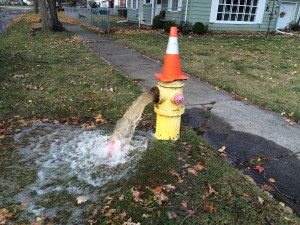Interview by Ashley O’Brien
LeeAnne Walters was once a stay-at-home mother of four. But she was transformed into an advocate for water safety in Flint and across the country after her four-year-old son Gavin got sick—the numbers on his blood tests clearly in the “action” range for lead poisoning.
Walters, 37, and her whole family – husband and four kids — experienced hair loss and rashes after the water source changed to the Flint River in 2014. But it was Gavin, a twin with brother Garrett, who had the worst reaction.
At one point, she said, Gavin’s blood lead level was 6.5 micrograms/deciliter, substantially above the 5 micrograms/deciliter point where, she said, medical researchers told her the definition of lead poisoning begins.
Born with a compromised immune system which made it harder for his body to process toxins, during the worst of it Gavin had to be bathed in bottled water. Even his clothes were washed outside the home.
Another of Walters’ children, J.D., who’s now 15, was the first to experience frightening health issues. Walters said he got sick last Thanksgiving at about the time the issue of TTHMs (Total Trihalomethanes) in the water came to light.
”He was in and out of the hospital and different doctors, they couldn’t figure out what was going on with him.” Walters said they continued drinking Flint water until “the water started coming through the filter brown. It was bogging the filter down so badly.”
When the family stopped drinking the water, J.D.’s health gradually returned. And Gavin seems to be slowly improving, although the family and their medical team have been on “watch and see” mode.
Propelled to action
Throughout the expanding crisis, Walters’ outrage propelled her to action.
She found herself putting in 16 to 20 hour days on top of caring for her family. She attended meetings, she got mad, she spoke up, she researched, she formed an advocacy group with another ally.
And eventually, she and a cadre of others – citizens, journalists, physicians, researchers — started to get results.
“I am ecstatic that they [state and local officials] are finally listening, that they are doing the right thing and going back to Detroit water,” Walters said. “I am saddened and sickened that it had to get to this point. My son shouldn’t have had to be poisoned for them to listen.”
Campaigned for Weaver
She said she is delighted about the outcome of the mayoral election. She and her family moved to Norfolk, Virginia a month ago after her Navy husband was transferred, but she came back to Flint to work the polls for Karen Weaver and to attend a town hall meeting.
“I’m ecstatic,” she said, speaking from Flint two days after the election. “We needed a change and now we’re going to get the change we need.”
“You can’t argue with science”
Walters, who had been a Flint resident since 1993 and graduated from Kearsley High School, has learned a lot of chemistry during the water crisis.
At meetings, she said, officials from the MDEQ and emergency manager Jerry Ambrose “called me a liar and they called me stupid,” she said.
“I am neither of those things, so I decided to go with the science. You can’t argue with science.”
Hydrant being flushed at Second and Greenfield streets, Flint
LeeAnne Walters’ family: how the facts emerged
Looking back, Walters details how the Walters’ family story progressed disturbingly for following J.D.’s problems.
In January, two months after her older son got sick, she received a notice about TTHMs in the water. By the time she found out about the TTHMs, it was too late to test to see it that was causing J.D.’s illness. “Since we didn’t know there was no way to prove it,” she said.
But the TTHM notice also warned about complication for people who compromised immune systems. That would include Gavin, one of her four-year-old twins.
“Every time he was in contact with the water, he was breaking out in this nasty scaly rash” Walters said. “It got to the point he was taking Benadryl before a bath because he would break out so badly.”
Walters had a lead test done on her home and found alarming results. A test done in February said Walters’ water had 104 parts per billion (ppb). Another test in March said there were 397 parts per billion. Federal guidelines warn about lead levels about 15 parts per billion (ppb).
“I knew if my numbers were that high, there had to be other places, especially with so many people throughout the city with the discolored water,” Walters said.
She began attending town meetings, talking about her water problem. She said city officials never took her seriously, and she was told “for months that the problem was strictly at my home, and that it wasn’t a city wide problem.”
Walters, Mays form Water You Fighting For
“I wasn’t fluent when it came to the workings of water before this, the chemicals that were used,” Walters said. “It was always something that was taken for granted. You pay for a service, you expect it to be clean and healthy and ours wasn’t.”
Walters met Melissa Mays at a public hearing at the City Hall Dome in January. The two women founded the advocacy group, Water You Fighting For. The group organized rallies, marches and meetings to do something about Flint’s toxic water. The organization eventually merged with other groups like The Concerned Pastors to form the Coalition for Clean Water.
Walters said she still couldn’t get people to listen, and she decided to change tactics. “That’s when she started learning the science.
Virginia Tech arrives on the scene
In the process, Walters reached out to the research team at Virginia Tech. Dr. Marc Edwards called to tell her that they would come to Flint.
“I cried.” Walters said of the phone call. “I was happy. I was relieved. Nobody else was helping. So to figure out a way to get help, and to be taken seriously and to prove when we’ve been saying for months and months and months was going to be brought to light. It was a relief.”
Dr. Edwards described Walters and her husband as “absolute heroes.”
“From the start, they made it clear they didn’t want any other children to get hurt,” Edwards said. “They literally turned their lives upside down to get to the truth of Flint’s water system.”
Much more to do
But Walters acknowledges there is much more work to do.
She plans to appear before the National Drinking Water Advisory Committee in Arlington, Virginia Nov. 18, a meeting Flint’s Congressman Dan Kildee also will attend. She said she is scheduled to meet with him there.
Since her new home is so close to Washington, D.C., she sees an opportunity to take her fight to the national level.
But she’s not letting go of the local advocacy either.
“And just because I’m not [living] in Flint doesn’t mean I’m stopping the fight.
“Now I am making sure that the testing they are doing now is up to par, that means taking out the loopholes,” Walters said. “They’re not trying to find the high lead that they’re supposed to be.
Loopholes on lead level testing
According to Walters, there are three main loopholes that are being taken advantage of in Michigan to hide high lead levels.
The three loopholes include pre-flushing the water before testing the sample, using small mouth bottles and capping the hours water can sit before testing.
Walters explained the small mouth bottles forces water to be collecting slowly, much differently than how people run the water when they go to fill up a glass.
“The bottles that the EPA use the mouth on the bottle is like the size of a regular glass, so that when you turn it on, the particulates in there are going into the bottle the way you drink it.”
Walters explains that the testing regulations is “a city fight, a state fight, and a national fight.” She said she is looking for loopholes other states might be using so she can get the EPA to reword the law. She wants the loopholes named as violations.
“It’s my personal mission to change the way of the testing and get rid of the loopholes,” Walters said. She said she would be going to Washington D.C. in November to talk to officials at the EPA about changing testing rules.
Flint politics played a role
“It’s very obvious that the city council and the mayor (outgoing Mayor Walling) are not interested in doing what’s best for the citizens. They’re interested in the bottom dollar,” Walters said. “The only person who heard us and stuck with us was [City Councilman] Eric Mays.”
Mays described Walters as “one of the champions of the water movement.”
“I give LeeAnne Walters credit. In the middle of the movement, we dealt with boil water advisories, TTHMs, we dealt with prices, and I give her the credit for championing the lead aspect of it, and sticking with it, until the point from Virginia Tech that the medical community, and the doctors from Hurley, apologized to the activists for taking so long.”
Mays explained that his sick mother once had to wait for an important surgery because of a rash, so when Walters told him about her son’s rashes, he took it very seriously.
“I don’t think that many people just complain about the problems with the water just to complain. There were just too many complaints for me to not pay attention,” Mays said. “When people cry out, listen close, and then try to learn more about what people are saying.”
Walters has been compared to Erin Brockovich, Harriet Tubman and Rosa Parks.
“There’s worse things in the world,” Walters joked about the comparison. “On the list of things I’ve done in my life, I would never have thought being an activist was one of them. I wouldn’t change it. Yes, I would change the fact that my son got poisoned, but I wouldn’t change the fact that I’m helping people.”
Staff writer Ashley O’Brien can be reached at am.obrien@rocketmail.com. EVM editor Jan Worth-Nelson contributed to this report. She can be reached at janworth1118@gmail.com.



You must be logged in to post a comment.